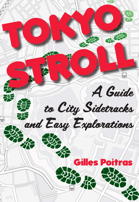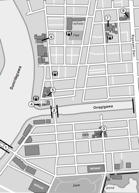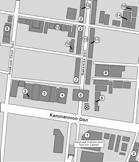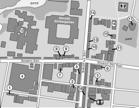











Tokyo Stroll Supplement: Ningyōchō

This page indexes, contains corrections and has additions to the Ningyōchō chapter of Tokyo Stroll.
For information on Tokyo Stroll and this web supplement see Tokyo Stroll Supplement home page
For users of the Organic Maps, Maps.Me and Google Maps apps the items below have bookmarks you can import into those apps to make navigation easier.
Instructions and links are on the Viewing Locations in Organic Maps, Maps.Me, Google Maps, or Google Earth page.
Some entries on this page may include a note that says "Description to be added soon ." These entries are for items I felt should be listed even if the description is not ready to assist those who wish to plan a trip. When possible I included a link to an official web page, I suggest also doing web searchs for more information.
Amazake Yokochō (甘酒横丁): Tokyo Stroll, Ningyōchō Chapter, page 280
NEAREST TRAIN/SUBWAY STATION: Ningyōchō Station (Tokyo Metro Hibiya Line, Toei Asakusa Line)
WEB:
http://amazakeyokocho.jp
Chanoki Shrine / Chanoki Jinja (茶ノ木神社): Tokyo Stroll, Ningyōchō Chapter, page 283
NEAREST TRAIN/SUBWAY STATION: Suitengūmae Station (Tokyo Metro Hanzōmon Line), Ningyōchō Station (Tokyo Metro Hibiya Line, Tōei Asakusa Line)
Gyokueidō (玉英堂): Tokyo Stroll, Ningyōchō Chapter, page 274
NEAREST TRAIN/SUBWAY STATION: Ningyōchō Station (Tokyo Metro Hibiya Line, Toei Asakusa Line)
Hamacho Green Road / Hamachō-gawa Midori michi (浜町川緑道)
Description to be added soon
NEAREST TRAIN/SUBWAY STATION: Ningyōchō Station (Tokyo Metro Hibiya Line, Toei Asakusa Line), Hamacho Station (Toei Shinjuku Line)
Hamachō Park / Hamachō Kōen (浜町公園): Tokyo Stroll, Ningyōchō Chapter, page 286
NEAREST TRAIN/SUBWAY STATION: Hamacho Station (Toei Shinjuku Line)
Hamadaya (濱田家): Tokyo Stroll, Ningyōchō Chapter, page 270
NEAREST TRAIN/SUBWAY STATION: Ningyōchō Station (Tokyo Metro Hibiya Line, Toei Asakusa Line)
Hiyama (日山): Tokyo Stroll, Ningyōchō Chapter, page 282
NEAREST TRAIN/SUBWAY STATION: Ningyōchō Station (Tokyo Metro Hibiya Line, Toei Asakusa Line)
WEB:
https://hiyama-gr.com
Imahan (人形町今半): Tokyo Stroll, Ningyōchō Chapter, page 282
NEAREST TRAIN/SUBWAY STATION: Ningyōchō Station (Tokyo Metro Hibiya Line, Toei Asakusa Line)
WEB:
https://www.imahan.com
Itakuraya (板倉屋): Tokyo Stroll, Ningyōchō Chapter, page 273
NEAREST TRAIN/SUBWAY STATION: Ningyōchō Station (Tokyo Metro Hibiya Line, Toei Asakusa Line)
WEB:
https://itakuraya.com
Iwai Tsuzuraya (岩井つづら屋): Tokyo Stroll, Ningyōchō Chapter, page 280
NEAREST TRAIN/SUBWAY STATION: Ningyōchō Station (Tokyo Metro Hibiya Line, Toei Asakusa Line)
Kaneman (かねまん): Tokyo Stroll, Ningyōchō Chapter, page 272
NEAREST TRAIN/SUBWAY STATION: Ningyōchō Station (Tokyo Metro Hibiya Line, Toei Asakusa Line)
Kanmidokoro Hatsune (甘味処 初音): Tokyo Stroll, Ningyōchō Chapter, page 283
NEAREST TRAIN/SUBWAY STATION: Suitengūmae Station (Tokyo Metro Hanzōmon Line), Ningyōchō Station (Tokyo Metro Hibiya Line, Tōei Asakusa Line)
Kasama Inari Shrine / Kasama Inari Jinja (笠間稲荷神社): Tokyo Stroll, Ningyōchō Chapter, page 285
NEAREST TRAIN/SUBWAY STATION: Hamacho Station (Toei Shinjuku Line)
Kissako Kaiseiken (喫茶去 快生軒): Tokyo Stroll, Ningyōchō Chapter, page 273
NEAREST TRAIN/SUBWAY STATION: Ningyōchō Station (Tokyo Metro Hibiya Line, Toei Asakusa Line)
Kizushi (喜寿司): Tokyo Stroll, Ningyōchō Chapter, page 270
NEAREST TRAIN/SUBWAY STATION: Ningyōchō Station (Tokyo Metro Hibiya Line, Toei Asakusa Line)
Koami Shrine / Koami Jinja (小網神社): Tokyo Stroll, Ningyōchō Chapter, page 271
NEAREST TRAIN/SUBWAY STATION: Ningyōchō Station (Tokyo Metro Hibiya Line, Toei Asakusa Line)
WEB:
https://www.koamijinja.or.jp
Kogiku Dōri (小菊通り): Tokyo Stroll, Ningyōchō Chapter, page 283
NEAREST TRAIN/SUBWAY STATION: Ningyōchō Station (Tokyo Metro Hibiya Line, Toei Asakusa Line)
Koharuken (小春軒): Tokyo Stroll, Ningyōchō Chapter, page 272
NEAREST TRAIN/SUBWAY STATION: Ningyōchō Station (Tokyo Metro Hibiya Line, Toei Asakusa Line)
Kotobukidō (壽堂): Tokyo Stroll, Ningyōchō Chapter, page 283
NEAREST TRAIN/SUBWAY STATION: Suitengūmae Station (Tokyo Metro Hanzōmon Line), Ningyōchō Station (Tokyo Metro Hibiya Line, Tōei Asakusa Line)
Matsushima Shrine / Matsushima Jinja (松島神社): Tokyo Stroll, Ningyōchō Chapter, page 284
NEAREST TRAIN/SUBWAY STATION: Suitengūmae Station (Tokyo Metro Hanzōmon Line), Ningyōchō Station (Tokyo Metro Hibiya Line, Tōei Asakusa Line)
Meiji Kannondō (明治観音堂): Tokyo Stroll, Ningyōchō Chapter, page 285
NEAREST TRAIN/SUBWAY STATION: Hamacho Station (Toei Shinjuku Line)
Meijiza (明治座): Tokyo Stroll, Ningyōchō Chapter, page 285
NEAREST TRAIN/SUBWAY STATION: Hamacho Station (Toei Shinjuku Line)
WEB:
https://www.meijiza.co.jp
Miharado (三原堂)
Description to be added soon
NEAREST TRAIN/SUBWAY STATIONS: Suitengūmae Station (Tokyo Metro Hanzōmon Line), Ningyōchō Station (Tokyo Metro Hibiya Line, Tōei Asakusa Line)
WEB: http://www.miharado-honten.co.jp
Morinoen (森乃園): Tokyo Stroll, Ningyōchō Chapter, page 275
NEAREST TRAIN/SUBWAY STATION: Ningyōchō Station (Tokyo Metro Hibiya Line, Toei Asakusa Line)
WEB:
https://morinoen.jp
Musée Hamaguchi Yōzō: Yamasa Collection (ミュゼ浜口陽三・ヤマサコレクション)
Coming from a family with several artists in its history and being the third son of the president of the Yamasa Shōyu company Yōzō Hamaguchi went on to become one of the world's most famous mezzotint artists. Among other things he developed the color mezzotint technique now used by many. He spent most of his career in Paris and San Francisco with a period in Japan from 1939-1953. He returned to Japan in 1996 and passed away in 2000. The museum opened in 1998, is operated by the Yamasa corporation and was set up with Yōzō's approval. The collection includes not only prints by him and his wife Keiko Minami, it also includes tools, various photographs, and occasional displays of works by other artists. There is also a cafe attached to the museum.
NEAREST TRAIN/SUBWAY STATION: Suitengūmae Station (Tokyo Metro Hanzōmon Line)
WEB: https://www.yamasa.com/musee/en/
Ningyōchō Imahan (人形町今半): Tokyo Stroll, Ningyōchō Chapter, page 282
NEAREST TRAIN/SUBWAY STATION: Ningyōchō Station (Tokyo Metro Hibiya Line, Toei Asakusa Line)
WEB:
https://www.imahan.com
Ningyōchō Karakuri Yagura (人形町からくり櫓): Tokyo Stroll, Ningyōchō Chapter, page 273
NEAREST TRAIN/SUBWAY STATION: Ningyōchō Station (Tokyo Metro Hibiya Line, Toei Asakusa Line)
Ningyōchō Shinodazushi (人形町志乃多寿司總本店): Tokyo Stroll, Ningyōchō Chapter, page 281
NEAREST TRAIN/SUBWAY STATION: Ningyōchō Station (Tokyo Metro Hibiya Line, Toei Asakusa Line)
WEB:
http://www.shinodazushi.co.jp
http://www.norenkai.net/en/portfolio-item/shinodazushi-sohonten/
Ōkannonji (大観音寺): Tokyo Stroll, Ningyōchō Chapter, page 282
NEAREST TRAIN/SUBWAY STATION: Ningyōchō Station (Tokyo Metro Hibiya Line, Toei Asakusa Line)
Sasaki Saketen (佐々木酒店): Tokyo Stroll, Ningyōchō Chapter, page 281
NEAREST TRAIN/SUBWAY STATION: Ningyōchō Station (Tokyo Metro Hibiya Line, Toei Asakusa Line)
WEB NOTE: The web page URL has changed to:
https://sasas.jp
Soba Tōshimaya (そば東嶋屋): Tokyo Stroll, Ningyōchō Chapter, page 280
NEAREST TRAIN/SUBWAY STATION: Ningyōchō Station (Tokyo Metro Hibiya Line, Toei Asakusa Line)
Suehiro Shrine / Suehiro Jinja (末廣神社): Tokyo Stroll, Ningyōchō Chapter, page 270
NEAREST TRAIN/SUBWAY STATION: Ningyōchō Station (Tokyo Metro Hibiya Line, Toei Asakusa Line)
Suitengū (水天宮): Tokyo Stroll, Ningyōchō Chapter, page 284
NOTE: This shrine sells ceramic charms in the form of a kappa.
NEAREST TRAIN/SUBWAY STATION: Suitengūmae Station (Tokyo Metro Hanzōmon Line)
WEB:
https://www.suitengu.or.jp
Tachibana Inari (橘稲荷神社): Tokyo Stroll, Ningyōchō Chapter, page 270
NEAREST TRAIN/SUBWAY STATION: Ningyōchō Station (Tokyo Metro Hibiya Line, Toei Asakusa Line)
Tamahide (玉ひで): Tokyo Stroll, Ningyōchō Chapter, page 272
NEAREST TRAIN/SUBWAY STATION: Ningyōchō Station (Tokyo Metro Hibiya Line, Toei Asakusa Line)
WEB:
http://www.tamahide.co.jp
Founded in 1930 and specializing in generous servings of sesame fried tempura, they serve a few other dishes such as sashimi and oyakodon. Their special sauce is from a batch that has been added to year after year since they were founded. This place has a relaxed environment with Western style seating.
NEAREST TRAIN/SUBWAY STATION: Ningyōchō Station (Tokyo Metro Hibiya Line, Toei Asakusa Line)
Tōfu no Futaba (とうふの双葉): Tokyo Stroll, Ningyōchō Chapter, page 280
NEAREST TRAIN/SUBWAY STATION: Ningyōchō Station (Tokyo Metro Hibiya Line, Toei Asakusa Line)
WEB:
http://www.tofunofutaba.com
Torihada (鳥波多): Tokyo Stroll, Ningyōchō Chapter, page 281
NEAREST TRAIN/SUBWAY STATION: Ningyōchō Station (Tokyo Metro Hibiya Line, Toei Asakusa Line)
WEB:
https://tori-hada.com
Toritada (鳥忠): Tokyo Stroll, Ningyōchō Chapter, page 281
NEAREST TRAIN/SUBWAY STATION: Ningyōchō Station (Tokyo Metro Hibiya Line, Toei Asakusa Line)
WEB:
https://www.toritada.co.jp
The restaurant has had a specialty in one dish aigamo sukiyaki since they opened in 1872. Aigamo sukiyaki is made with the meat of a duck that is the offspring resulting from crossbreeding a wild and a domestic duck. The restaurant was renovated in 2005 and has both traditional at horigotatsu and Western seating. It is sometimes referred to as Sukiyaki Toriyasu.
NEAREST TRAIN/SUBWAY STATION: Higashi-nihombashi Station (Toei Asakusa Line)
WEB: https://aigamotoriyasu.com
http://www.norenkai.net/en/portfolio-item/toriyasu/
Tsukushi (つくし): Tokyo Stroll, Ningyōchō Chapter, page 283
NEAREST TRAIN/SUBWAY STATION: Suitengūmae Station (Tokyo Metro Hanzōmon Line), Ningyōchō Station (Tokyo Metro Hibiya Line, Tōei Asakusa Line)
WEB:
https://tsukushi.tokyo
Ubukeya (うぶけや): Tokyo Stroll, Ningyōchō Chapter, page 270
NEAREST TRAIN/SUBWAY STATION: Ningyōchō Station (Tokyo Metro Hibiya Line, Toei Asakusa Line)
WEB:
https://www.ubukeya.com
Whales, the Sea, and Ningyōchō / Kujira to umi to Ningyōchō (鯨と海と人形町)
[sculpture] Description to be added soon
NEAREST TRAIN/SUBWAY STATIONS: Suitengūmae Station (Tokyo Metro Hanzōmon Line), Ningyōchō Station (Tokyo Metro Hibiya Line, Tōei Asakusa Line)
One of the major Fudō Myōō temples of Tokyo and a branch of Kawasaki Daishi Heikenji, a major Shingon temple in Kawasaki. The main object of veneration here is a Fudō statue from the 12th century which was brought to Edo in 1585 after the temple it was in was burned down in a battle. As the statue was carried in a wicker box the statue came to be called the Tsuzura Fudō Myōō, that is "Fudō Myōō in a wicker box" The temple itself is on a small plot of land and shaped like a pagoda with a long stairway leading to it.
NEAREST TRAIN/SUBWAY STATION: Higashi-nihombashi Station (Toei Asakusa Line)
EVENTS: Around December 28 there is the Toshi no Ichi, a three-day fair held here.
Yanagiya (柳屋): Tokyo Stroll, Ningyōchō Chapter, page 280
NEAREST TRAIN/SUBWAY STATION: Ningyōchō Station (Tokyo Metro Hibiya Line, Toei Asakusa Line)
Yoshiume (よし梅): Tokyo Stroll, Ningyōchō Chapter, page 282
NEAREST TRAIN/SUBWAY STATION: Ningyōchō Station (Tokyo Metro Hibiya Line, Toei Asakusa Line)
WEB:
http://www.yoshiume.jp/honten.html
Back to the Tokyo Stroll Supplement home page - Privacy Notice - Back to Gilles' home page
Created July 10, 2919 | Content last updated September 20, 2025